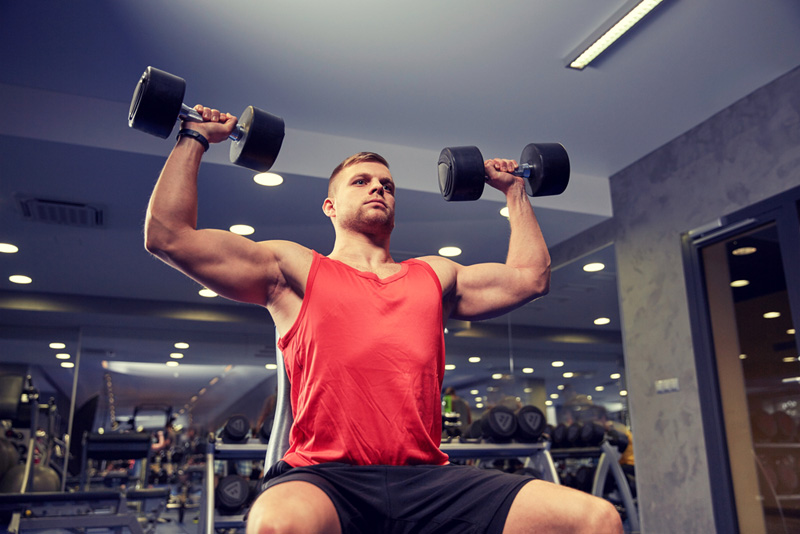Is Lifting Weights Causing Your Wrist Pain?

Many people frequent the gym to lose weight, build muscle, or get toned outside of the apparent health benefits. Lifting weights can boost your mood and confidence, especially if it is part of your daily routine. However, sometimes these workouts can lead to pain, discomfort, and injury, especially in the wrists.
There are several reasons why you may be feeling wrist pain, including a sedentary lifestyle or job, overuse of repetitive movements such as typing, driving, and even going to the gym. Generally, wrist pain is gradual, but it can also be the result of an injury. If you are connecting your wrist pain with your workouts, there are several reasons why that may be so.
Contents
Improper form
For the novice weightlifter, lifting heavy (and quickly) may be an ambitious goal. While this is possible, if you do not take the time to learn proper form, you may put yourself at high risk for injury.
For example, Hammer curls appear to be a simple exercise: you hold the dumbbell like a hammer, curl it towards your body and back down again before curling back up. With proper form, you will be curling the weight and squeezing your bicep at the top, and controlling the weight as it goes down without using your back or core to jerk it back up. This may not be a lightweight problem, but if you have not taken the time to control the movement correctly, your wrists will be at serious risk.
Your hands are used in nearly every exercise, which is why it is so important to learn proper techniques for all of your lifts. A personal trainer can pinpoint exactly where your form is lacking and keep you on the right track for your goals.
Lifting too heavy
Similar to improper form, lifting too heavy too soon can be a problem for your joints. When weight is too heavy, your body will compensate by using other muscles, putting added strain on your already tired self.
Progressive overload is key to building muscle, but it is vital not to overload your muscles with excessive weight or too many reps. Exercise already taxes your muscles, so you do not need to exert yourself to the point of exhaustion. Again, this will put too much force on your joints and will likely lead to wrist pain.
Following a workout program or keeping track of your workouts in a journal or app is a great way to ensure your joints are not overly stressed. This is also a simple method to look back on your progress and recycle old workouts if you do not like your current regimen.
Working out too much
Physical fitness and moving your body throughout the day are necessary, but rest days are equally important. For individuals pursuing a particular physique or competing in a sport, rest days may seem blasphemous. Of course, too many rest days in a row is counterintuitive, but having at least one rest day a week is crucial for your health and muscle growth.
Nagging injuries such as wrist pain from weight lifting are often gradual, so it may be tempting to act tough and work through the pain, but it the exact opposite of what you should do. You should never feel pain while exercising unless it is the “burning” sensation from the exercise itself. Ignoring your pain will likely lead to much worse conditions.
Rest days are essential for your physical health and your mental health as well. Active rest days are an option, such as a long walk or a quick hike if you are still itching to get moving. However, persistent pain in your wrists is a clear sign of a problem that needs medical attention.
Acute injury
Acute injuries are easy to distinguish because it is sudden pain from an injury. Even if you are not training for a sport, there is always a possibility of damage. Improper form, picking up a heavyweight, or dropping weight can cause an acute injury. Sudden pain will indicate where the pain is, and not receiving proper treatment for the damage can turn it into a chronic condition or radiate to other parts of your body.
Resting your wrist can reduce pain and swelling, along with applying ice every hour or so. Over-the-counter medication such as Tylenol can help if your pain is persistent. Of course, if your wrist pain continues to bother you, especially throughout the day, it is best to seek a doctor.
When to see a doctor
Your body will tell you when it is in pain, even if you choose to ignore it. Your hands and wrists are used in most lifts, even compound movements such as deadlifts and squats. If you feel an odd twang during your bicep curls, it may be a random instance, but if you notice consistent pain in your wrists, then it is time to get evaluated by a doctor.
Conclusion
Lifting weights at the gym is a great way to sculpt your body and your health. It boosts your mood and can make the day more productive. Unfortunately, nothing in life is without risk, and even if minor, lifting weights can put you at risk for wrist pain.
Improper form, lifting too much weight too quickly, working out too frequently, and injury are just a few of the possible causes of your wrist pain if you are often in the gym. Hiring a personal trainer to teach you proper technique and how to progressively overload your muscles may prevent joint and other pains if you are new to the gym. Logging your progress in a journal can give you a clue as to where your pain started if you keep detailed notes.
If you are experiencing wrist pain in general, it is best to schedule an appointment with your doctor to diagnose and treat it appropriately.

























